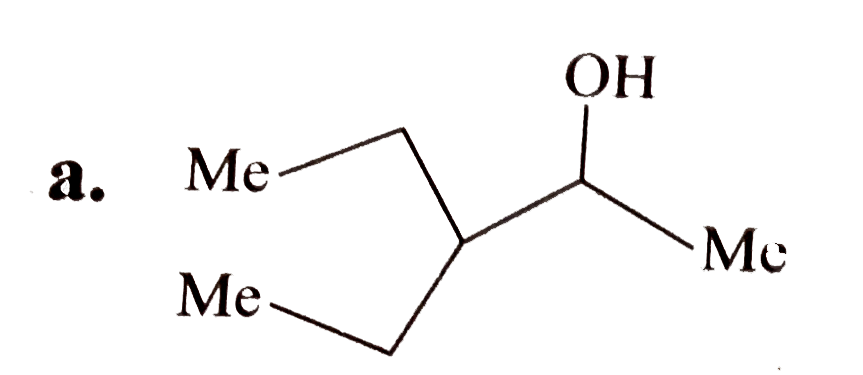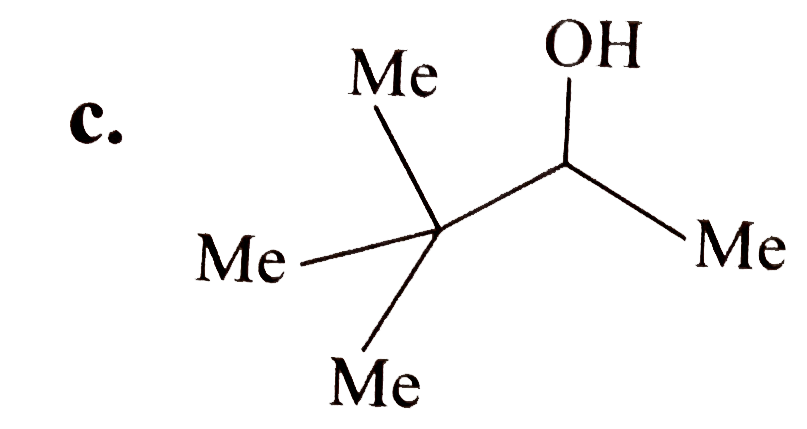(a) Predict the major product of acid catalysed dehydration of 1-Methylcyclohexanol.
(b) You are given benzene, conc. H2SO4,NaOH and did. HCI. Write the preparation of phenol using these reagents.
Step-by-Step Solution
1. Identify the structure of 1-Methylcyclohexanol:
- The structure consists of a cyclohexane ring with a methyl group (−CH₃) and a hydroxyl group (−OH) attached to it.
2. Understand the dehydration process:
- Dehydration of alcohols involves the removal of a water molecule (−H₂O) and typically occurs under acidic conditions, which can lead to the formation of alkenes.
3. Determine the mechanism:
- The dehydration of 1-Methylcyclohexanol proceeds via an E1 mechanism, where the hydroxyl group is protonated to form a better leaving group (water), followed by the formation of a carbocation.
4. Carbocation stability:
- In this case, the carbocation formed after the loss of water will be a secondary carbocation (due to the presence of the methyl group), which is more stable than a primary carbocation.
5. Identify the major product:
- The major product will be the alkene formed from the most stable carbocation, which is 1-Methylcyclohexene. The double bond will form between the carbon that was initially attached to the hydroxyl group and the adjacent carbon in the ring.
Final Answer for (a):
The major product of the acid-catalyzed dehydration of 1-Methylcyclohexanol is 1-Methylcyclohexene.
---
(b) Preparation of phenol using benzene, concentrated H₂SO₄, NaOH, and diluted HCl.
1. Sulfonation of Benzene:
- Benzene is treated with concentrated sulfuric acid (H₂SO₄) to form benzene sulfonic acid. This reaction involves the electrophilic substitution of a hydrogen atom on the benzene ring with a sulfonyl group (−SO₃H).
C6H6+H2SO4→C6H5SO3H(Benzene sulfonic acid)
2. Formation of Sodium Phenoxide:
- The benzene sulfonic acid is then treated with sodium hydroxide (NaOH) at elevated temperatures. This reaction leads to the formation of sodium phenoxide.
C6H5SO3H+NaOH→C6H5O−Na++Na2SO4
3. Hydrolysis to form Phenol:
- Finally, the sodium phenoxide is treated with diluted hydrochloric acid (HCl) to hydrolyze it and produce phenol.
C6H5O−Na++HCl→C6H5OH+NaCl
Final Answer for (b):
The preparation of phenol from benzene involves:
1. Sulfonation of benzene with concentrated H₂SO₄ to form benzene sulfonic acid.
2. Reaction of benzene sulfonic acid with NaOH to form sodium phenoxide.
3. Hydrolysis of sodium phenoxide with diluted HCl to yield phenol.
---
- The structure consists of a cyclohexane ring with a methyl group (−CH₃) and a hydroxyl group (−OH) attached to it.
- Dehydration of alcohols involves the removal of a water molecule (−H₂O) and typically occurs under acidic conditions, which can lead to the formation of alkenes.
- The dehydration of 1-Methylcyclohexanol proceeds via an E1 mechanism, where the hydroxyl group is protonated to form a better leaving group (water), followed by the formation of a carbocation.
- In this case, the carbocation formed after the loss of water will be a secondary carbocation (due to the presence of the methyl group), which is more stable than a primary carbocation.
- The major product will be the alkene formed from the most stable carbocation, which is 1-Methylcyclohexene. The double bond will form between the carbon that was initially attached to the hydroxyl group and the adjacent carbon in the ring.
The major product of the acid-catalyzed dehydration of 1-Methylcyclohexanol is 1-Methylcyclohexene.
- Benzene is treated with concentrated sulfuric acid (H₂SO₄) to form benzene sulfonic acid. This reaction involves the electrophilic substitution of a hydrogen atom on the benzene ring with a sulfonyl group (−SO₃H).
- The benzene sulfonic acid is then treated with sodium hydroxide (NaOH) at elevated temperatures. This reaction leads to the formation of sodium phenoxide.
- Finally, the sodium phenoxide is treated with diluted hydrochloric acid (HCl) to hydrolyze it and produce phenol.
The preparation of phenol from benzene involves:
1. Sulfonation of benzene with concentrated H₂SO₄ to form benzene sulfonic acid.
2. Reaction of benzene sulfonic acid with NaOH to form sodium phenoxide.
3. Hydrolysis of sodium phenoxide with diluted HCl to yield phenol.
Similar Questions
Knowledge Check
The major product of acid catalysed dehydration of 2-methylcyclohexanol and butan-1-ol are respectively
A1-methylcyclohexene and but-1-eneB2-methylcyclohexene and but-2-eneC2-methylcyclohexene and butaneD1-methylcyclohexene and but-2-ene.
Predict the product when alcohol
 undergoes dehydration with conc. H2SO4.
undergoes dehydration with conc. H2SO4.
View SolutionThe major product obtained in the reaction of oxalic acid with conc, H2SO4 upon heating are
View SolutionGive the products of the reaction with conc. H2SO4 of :
a.
b.
c.
d. 1- Methyl cyclohexanol
View SolutionWrite the equation for the lab preparation of HNO3 from potassium nitrate and conc . H2SO4.
View SolutionDehydration of butan −2−ol with conc. H2SO4 gives preferred product.
View SolutionIn the nitration of benzene using a mixture of conc. H2SO4 and conc. HNO3 , the species which initiates the reaction is…
View SolutionIn the nitration of benzene using a mixture of conc. H2SO4 and conc. HNO3 , the species which initiates the reaction is…
View Solution
